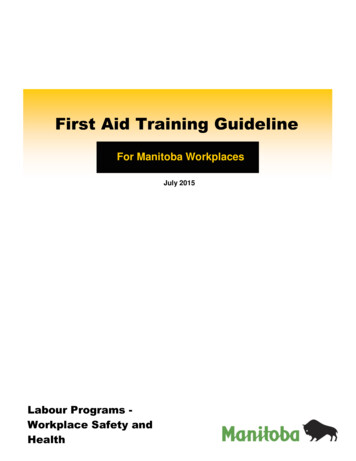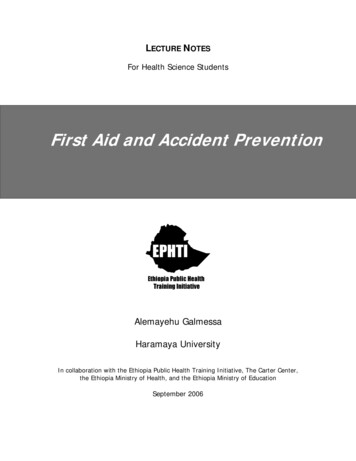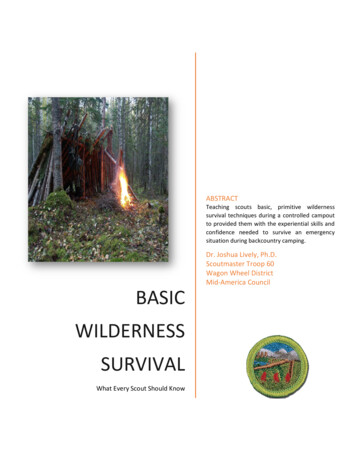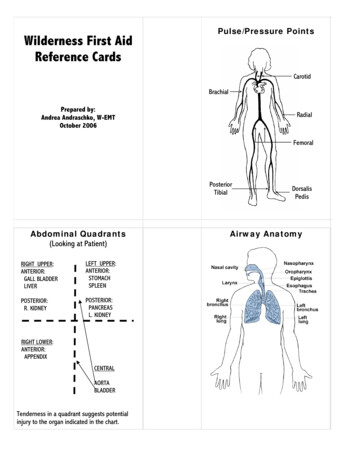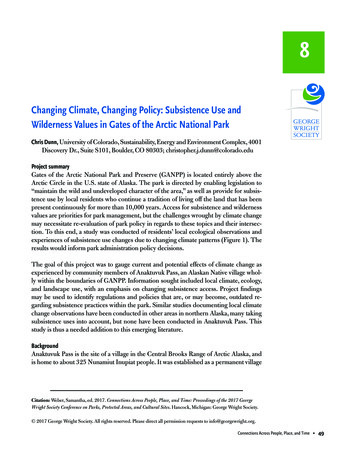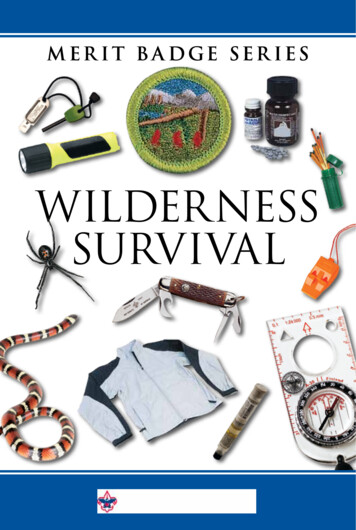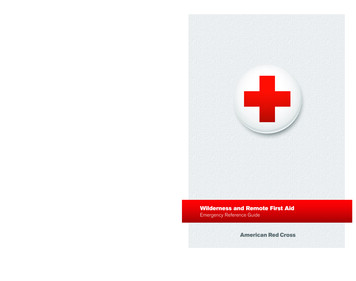
Transcription
Wilderness and Remote First AidEmergency Reference Guide
Wilderness and Remote First AidEmergency Reference GuideSpecial thanks to the Boy Scouts of America for facilitating the task force that produced theWilderness First Aid Curriculum and Doctrine Guidelines.The following organizations provided review of the materials and/or support for theAmerican Red Cross Wilderness and Remote First Aid program:
Content in the Wilderness and Remote First Aid Emergency Reference Guide is based on the 2010Boy Scouts of America (BSA) Wilderness First Aid Curriculum and Doctrine Guidelines and reflectsthe 2010 Consensus on Science for CPR and Emergency Cardiovascular Care and the 2010Guidelines for First Aid. The Wilderness First Aid Curriculum and Doctrine Guidelines were developedthrough a task force facilitated by the BSA. The Wilderness and Remote First Aid course carefullyfollows these guidelines.The emergency care procedures outlined in this manual reflect the standard of knowledge andaccepted emergency practices in the United States at the time this manual was published. It is thereader’s responsibility to stay informed of changes in the emergency care procedures.PLEASE READ THE FOLLOWING TERMS AND CONDITIONS BEFORE AGREEING TO ACCESSAND DOWNLOAD THE AMERICAN RED CROSS MATERIALS. BY DOWNLOADING THEMATERIALS, YOU HEREBY AGREE TO BE BOUND BY THE TERMS AND CONDITIONS.The downloadable electronic materials, including all content, graphics, images and logos, arecopyrighted by and the exclusive property of The American National Red Cross (“Red Cross”). Unlessotherwise indicated in writing by the Red Cross, the Red Cross grants you (“recipient”) the limited rightto download, print, photocopy and use the electronic materials, subject to the following restrictions: The recipient is prohibited from reproducing the materials for any reason.The recipient is prohibited from creating electronic versions of the materials.The recipient is prohibited from revising, altering, adapting or modifying the materials.The recipient is prohibited from creating any derivative works incorporating, in part or in whole, thecontent of the materials.The recipient is prohibited from downloading the materials and putting them on their own websitewithout Red Cross permission.Any rights not expressly granted herein are reserved by the Red Cross. The Red Cross does not permitits materials to be reproduced or published without advance written permission from the Red Cross. Torequest permission to reproduce or publish Red Cross materials, please submit your written request toThe American National Red Cross.Copyright 2014 American Red Cross. ALL RIGHTS RESERVED.The Red Cross emblem, American Red Cross and the American Red Cross logo are trademarks ofThe American National Red Cross and protected by various national statutes.Published by Krames StayWell Strategic Partnerships DivisionISBN: 978-1-58480-629-5
AcknowledgmentsThe American Red Cross Wilderness and Remote First Aid program and supportingmaterials were developed through the dedication of both employees and volunteers.Their commitment to excellence made this program possible.
ContentsSkill SheetsRemoving GlovesChecking an Injured or Ill AdultChecking an Injured or Ill ChildCPR—Adult or ChildAED—Adult or ChildConscious Choking—Adultor Child2357810Injuries and IllnessesAs Reflected in Boy Scouts of America WildernessFirst Aid Curriculum and Doctrine GuidelinesWilderness and Remote FirstAid KitsCHECK—CALL—CARE forthe WildernessAbdominal ProblemsAllergies and AnaphylaxisAltitude IllnessesBone and Joint InjuriesBurnsChest InjuriesHead (Brain), Neck andSpinal InjuriesHeat-Related IllnessesHypothermiaLightningShock and Heart AttackSubmersion Incidents (Drowning)Wounds and Wound s and remote first aid emergency reference guide
Special SituationsAbdominal Injuries and IllnessesAsthma AttackCold-Related EmergenciesConfined SpacesDiabetic EmergencyEmergency andNon-Emergency MovesEmergency ChildbirthEye, Mouth and Lip InjuriesPoisoningSeizuresSnow BlindnessStrokeWound sv
Photo CreditsSelect Photography: Barbara ProudTable of Contents Photography: iperdesign, Inc.Injuries and Illnesses Section Opener: iStockphoto.com/Arthur Carlo FrancoSpecial Situations Section Opener: Image Copyright robcocquyt,2009 Used under license from Shutterstock.comMany thanks to Keith Van Derzee and the YMCA Camp Ockanickonstaff for opening the camp to us and providing assistance with thephotography shoot.viwilderness and remote first aid emergency reference guide
SkillSheets
removing glovesREMOVING GLOVESAFTER GIVING CARE AND MAKING SURE TO NEVER TOUCH THE BARESKIN WITH THE OUTSIDE OF EITHER GLOVE:PINCH GLOVEPinch the palm side of one glove near thewrist. Carefully pull the glove off so that it isinside out. SLIP TWO FINGERSUNDER GLOVEHold the glove in the palm of the remaininggloved hand. Slip two fingers under theglove at the wrist of the remaining glovedhand.PULL GLOVE OFFPull the glove until it comes off, inside out,so that the first glove ends up inside theglove just removed.4 DISPOSE OF GLOVES AND WASH HANDSAfter removing the gloves:2 Dispose of gloves in the appropriate biohazard container. Wash hands thoroughly with soap and warm running water, if available. If soap and running water are unavailable and hands are not visibly soiled,rub hands thoroughly with an alcohol-based hand sanitizer.wilderness and remote first aid emergency reference guide
APPEARS TO BE UNCONSCIOUSChecking aninjured or ill adultCHECKING AN INJUREDOR ILL ADULTUse disposable gloves and other personal protective equipment (PPE).AFTER CHECKING THE SCENE FOR SAFETY, CHECK THE PERSON:CHECK FOR RESPONSIVENESSTap the shoulder and shout, “Are you OK?” IF NO RESPONSE, CALL 9-1-1 OR THE LOCAL EMERGENCYNUMBERSend someone to get an AED, if possible. If an unconscious person is face-down, roll him or her face-up keeping thehead, neck and back in a straight line.If the person responds, obtain consent and call 9-1-1 or the local emergencynumber for any life-threatening conditions. Check the responsive person fromhead to toe and ask questions to find out what happened.OPEN THE AIRWAYTilt head; lift chin.Continued on next pageSkill Sheets3
Checking aninjured or ill adultContinued4 CHECK FOR BREATHINGCheck for no more than 10 seconds. Occasional gasps are not breathing.5 QUICKLY SCAN FOR SEVERE BLEEDINGWHAT TO DO NEXT4 If there is no breathing, perform CPR or use an AED (if AED is immediatelyavailable). If breathing, maintain an open airway and monitor breathing and for anychanges in condition.wilderness and remote first aid emergency reference guide
APPEARS TO BE UNCONSCIOUSChecking aninjured or ill childCHECKING AN INJUREDOR ILL CHILDUse disposable gloves and other PPE. Get consent from a parent or guardian,if present.AFTER CHECKING THE SCENE FOR SAFETY, CHECK THE CHILD:CHECK FOR RESPONSIVENESSTap the shoulder and shout, “Are you OK?” IF NO RESPONSE, SEND SOMEONE TO CALL 9-1-1 OR THELOCAL EMERGENCY NUMBERSend someone to get an AED, if possible. If an unconscious child is face-down, roll him or her face-up keeping thehead, neck and back in a straight line.If ALONE, give about 2 minutes of care, then call 9-1-1.If the child responds, call 9-1-1 or the local emergency number for anylife-threatening conditions and obtain consent to give care. Check the responsivechild from head to toe and ask questions to find out what happened.OPEN THE AIRWAYTilt head back slightly; lift chin.4 CHECK FOR BREATHINGCheck for no more than 10 seconds. Occasional gasps are not breathing.Continued on next pageSkill Sheets5
Checking aninjured or ill childContinued5 IF NO BREATHING,GIVE 2 RESCUE BREATHS Tilt the head back and lift the chin up. Pinch the nose shut then make acomplete seal over the child's mouth. Blow in for about 1 second to make thechest clearly rise. Give rescue breaths, one after the other.If chest does not rise with the initial rescuebreath, retilt the head before giving the second breath.If you witnessed the child suddenly collapse, skip rescue breaths and start CPR.6 QUICKLY SCAN FOR SEVERE BLEEDINGWHAT TO DO NEXT6 If the second breath does not make the chest rise, the child may be choking.Give care for unconscious choking by performing CPR, starting withcompressions. If there is no breathing, perform CPR or use an AED (if AED is immediatelyavailable). If breathing, maintain an open airway. Monitor breathing and for any changesin condition.wilderness and remote first aid emergency reference guide
No Breathingcpr—adult or childCPR–ADULT OR CHILDAfter checking the scene and the injured or ill person:GIVE 30 CHEST COMPRESSIONSPush hard, push fast in the middleof the chest at a rate of at least 100compressions per minute. Adult: Push at least 2 inches deep. Child: Push about 2 inches deep.The person must be on firm, flat surface.GIVE 2 RESCUE BREATHS Tilt the head back and lift the chin up. Pinch the nose shut then make acomplete seal over the person’s mouth. Blow in for about 1 second to make thechest clearly rise. Give rescue breaths, one after the other.If chest does not rise with the initial rescuebreath, retilt the head before giving the second breath.If the second breath does not make the chest rise, the person may be choking.After each subsequent set of chest compressions and before attempting breaths,look for an object and, if seen, remove it. Continue CPR.DO NOT STOPContinue cycles of CPR. Do not stop except in one of these situations: You find an obvious sign of life (such as breathing). An AED is ready to use. Another trained responder or EMS personnel take over. You are too exhausted to continue. The scene becomes unsafe.WHAT TO DO NEXT Use an AED as soon as one is available. If at any time you notice an obvious sign of life, stop CPR and monitorbreathing and for any changes in condition.Skill Sheets7
AED—Adult or childAED–ADULT OR CHILDOLDER THAN 8 YEARSOR WEIGHING MORETHAN 55 POUNDSNo BreathingAFTER CHECKING THE SCENE AND THE INJURED OR ILL PERSON,HAVE SOMEONE CALL 9-1-1:TURN ON AEDFollow the voice and/or visual prompts.WIPE BARE CHEST DRYRemove any medication patches with a gloved hand.ATTACH PADSDo not use pediatric AED pads orequipment on an adult or child older than8 years or weighing more than 55 pounds.4 PLUG IN CONNECTOR,IF NECESSARY8wilderness and remote first aid emergency reference guide
Make sure no one, including you, istouching the person. Say, “Everyone, STAND CLEAR.”AED—Adult or child5 STAND CLEAR6 LET THE AED ANALYZE HEART RHYTHMPush the “analyze” button, if necessary.7 DELIVER SHOCK, IF ADVISED Make sure no one, including you, istouching the person. Say, “Everyone, STAND CLEAR.” Push the “shock” button, if necessary.8 PERFORM CPRAfter delivering the shock, or if no shock is advised: Perform about 2 minutes (or 5 cycles) of CPR. Continue to follow the prompts of the AED.If at any time you notice an obvious sign of life, stop CPR and monitor breathingand for any changes in condition.If two trained responders are present, one should perform CPR while the otheroperates the AED.Skill Sheets9
conscious choking—adult or childCONSCIOUS CHOKING–ADULT OR CHILDCANNOT COUGH, SPEAK OR BREATHEAFTER CHECKING THE SCENE AND THE INJURED OR ILL PERSON,HAVE SOMEONE CALL 9-1-1 AND GET CONSENT:GIVE 5 BACK BLOWSBend the person forward at the waist andgive 5 back blows between the shoulderblades with the heel of one hand.Stand or kneel behind a child, dependingon his or her size.GIVE 5 ABDOMINAL THRUSTS Place a fist with the thumb side againstthe middle of the person’s abdomen,just above the navel. Cover your fist with your other hand. Give 5 quick, upward abdominal thrusts.CONTINUE CAREGive sets of 5 back blows and 5 abdominalthrusts until the: Object is forced out. Person can cough forcefully or breathe. Person becomes unconscious.WHAT TO DO NEXT10 If the person becomes unconscious, call 9-1-1 if not already done. Carefully lower him or her to the ground and begin CPR, starting withcompressions.wilderness and remote first aid emergency reference guide
InjuriesandIllnessesAs Reflected in Boy Scouts of America WildernessFirst Aid Curriculum and Doctrine Guidelines
Wilderness and RemoteFirst Aid KitsInclude the following contents inpersonal and group wilderness andremote first aid kits (Figure 1):Personal First AidKitnnnnnnnnnnnAdhesive bandages (6)Sterile gauze pads, 3- -3-inch (2)Adhesive tape (1 small roll)Moleskin, 3- -6-inch (1)Soap (1 small bar) or alcohol-basedFigure 1hand sanitizing gel (1 travel-sizedbottle)Wound gel (1 small tube)Scissors (1 pair)Latex-free medical exam gloves (1 pair)Cardiopulmonary resuscitation (CPR) breathing barrier (1)Tweezers (1)Wilderness and Remote First Aid Report Form/Rescue Request and pencilGroup First Aid Kitnnnnnnnnn12Gauze bandage, 3-inch rolls (2)Self-adhesive bandage, 2-inch roll (1)Adhesive tape, 1-inch rolls (2)Alcohol pads (12)Povidone-iodine pads (12)Assorted adhesive bandages (1 box)Elastic bandages, 3-inch-wide (2)Sterile gauze pads, 4- -4-inch (12)Moleskin, 3- -6-inch (4)wilderness and remote first aid emergency reference guide
nnnnnnnnnnnnGel pads for blisters and burns (2 packets)Wound gel (1 tube)Hydrocortisone cream 1 percent (1 tube)Triangular bandages (4)Soap (1 small bar) or alcohol-based hand sanitizing gel (1 travel-sized bottle)Scissors (1 pair)Tweezers (1 pair)Safety pins (12)Latex-free medical exam gloves (6 pairs)Protective goggles/safety glasses (1 pair)Wilderness and RemoteFirst Aid KitsnCPR breathing barrier (1)Wilderness and Remote First Aid Report Form/Rescue Request and pencilOptional items: Instant cold compress Space blanket Original size SAM SplintAdditional Items Mentioned in Coursefor ConsiderationnnnnnnnnnnnnnnDenture adhesiveIrrigation syringeThermometerCommercial tourniquetIbuprofenChewable low-dose aspirin (81 mg each)AcetaminophenOral antihistamineProperly labeled prescription medications for individuals (e.g., EpiPen ,nitroglycerin, high-altitude drugs)NeedleAlcohol (and/or vinegar)Tampons/padsDecongestant nasal sprayOver-the-counter diarrhea medicationInjuries and Illnesses13
Wilderness and RemoteFirst Aid KitsnnZinc oxide powderChemical heat packsNOTE The person should only take medication if he or she can swallow and hasno known contraindications. Individuals should read and follow all labelor health care provider instructions. Check state and local regulationsregarding use of prescription and over-the-counter medications. Aspirinand products containing aspirin should not be given to a child youngerthan 19 years of age if he or she has a fever-causing illness.Other Important Items That Are Useful inFirst Aid and Other EmergenciesnnnnnnnnnnnFull water bottle(s) (especially in waterless areas)Water purification and backupGround insulation (e.g., a “sit-upon” camp mat)Shelter (could be a plastic tube shelter)SAM SplintPlastic bagEmergency blanketSignaling device (e.g., mirror, whistle)Duct tapeIdentification/medical formSpecial environmental essentials (e.g., ice axe, cold weather sailing gear)NOTE No piece of equipment is as valuable as the person who uses it.14wilderness and remote first aid emergency reference guide
heck Call CareCfor the WildernessIf you find yourself in an emergency, you should follow three basic emergencyaction principles: CHECK—CALL—CARE. These principles will help guide you incaring for the injured or ill person and will help ensure your own safety.CHECK:Check the Scene, the Resources and the PersonCHECK the ScenennnnnnEstablish control and recognize the emergency.CHECK the scene before you approach to make sure it is safe for you, theperson, other members of the group and any bystanders.Follow standard precautions to prevent disease transmission.Obtain consent from a conscious person or, if a minor, from the parent orguardian. If the person is unconscious, consent is implied.CHECK for clues about the mechanism of injury (MOI) or nature of the illness.Move the person only if necessary to prevent additional harm.NOTE If the scene is not safe and there is a way to call for additional help, doso quickly. Be ready to continue checking and caring for the person if thescene becomes safe.CHECK the ResourcesnIdentify available resources, including materials and additionaltrained responders.Injuries and Illnesses15
CHECK—call—care forthe wildernessCHECK the PersonPrimary (Initial) AssessmentUse the ABCDEs to assess life-threateningconditions.n A If the person is unconscious,use the head-tilt/chin-lift techniqueto open the airway (Figure 1).A person who is speaking orbreathing has an open airway, butask if he or she is having problemsbreathing.nn16B Look, listen and feel formovement, normal breathingand quality of breathing (forFigure 1no more than 10 seconds)(Figure 2). If an unconsciousadult is not breathing or is notbreathing normally, assume acardiac emergency and begincardiopulmonary resuscitation(CPR). For a child or a knowndrowning or respiratory emergency,give 2 rescue breaths beforestarting CPR.Figure 2C Assess the person's circulation byscanning the body for severe bleeding. If severely bleeding, use direct pressure tocontrol the bleeding.wilderness and remote first aid emergency reference guide
nD Look for any disability as a result of damage to the spinal cord. If yoususpect a spinal injury, minimize movement of the head, neck and spine.Manually support the head in the position found.E Assess the threat of the environment and expose any injuries. Lookfor signs and symptoms of exposure to extreme environmental conditions,especially extreme heat and cold weather, which can cause changes to thebody’s temperature and threaten a person’s life. It is important to protect theperson from extreme conditions, but if necessary, you may expose part of theperson’s skin to assess the damage and to give care.CHECK—call—care forthe wildernessnIf you find a life-threatening condition during the primary assessment, CALL forhelp if possible and give CARE for the condition found. The caller should beprepared with information about the person, location/environment and resources(people and materials). If you do not find a life-threatening condition, continue tothe secondary assessment and SAMPLE history before giving specific care for aninjury or illness.Secondary (Focused) AssessmentHands-On Physical ExamCheck the person head to toe during the hands-on physical exam, going in thefollowing order: head, face, ears, neck, chest, abdomen, pelvis, genitalia, eacharm, each leg and back.n Look for DOTS: D Deformity O Open injuries T Tenderness S SwellingnnCheck circulation, sensation and motion (CSM) at each extremity.Assess skin color, temperature and moisture.Level of ConsciousnessUse AVPU to describe the person's level of consciousness (LOC).n A Alert and able to answer orientation questions A O 4: knows who (name), where (current location), when (day) andwhat happened A O 3: knows who, where and when A O 2: knows only who and where A O 1: knows only whoInjuries and Illnesses17
CHECK—call—care forthe wildernessnnnV Responds only to verbal stimuli (e.g., by grimacing or rolling away fromyour voice when you speak or shout)P Responds only to painful stimuli (e.g., pinch)U Unresponsive to any stimuliNormal Vital Signs for an AdultnnnRespiratory rate (breath): 12 to 20 breaths per minute; regular andunlabored paceHeart rate (pulse): 60 to 100 beats per minute; strong and regularSkin color, temperature and moisture: pink, warm and dry to the touchSAMPLE HistoryUse the SAMPLE history to gain essential information about the person's medicalhistory. Ask the person questions, such as those listed below, and record theanswers on the Wilderness and Remote First Aid Report Form/Rescue Request:n S Signs and symptoms. What are your signs and symptoms (i.e., whathurts)? How do you feel? Are you experiencing any pain, nausea, lightheadedness or other things that are not visible?n A Allergies. Do you have any known allergies or allergic reactions? Whathappens? Has there been any recent exposure?n M Medications. What medications are you taking? Are they over-thecounter or prescription? What is the medication for? When was it last taken?Can you tell me where the medication is so we can keep it with you?n P Pertinent past medical history. Has anything like this happened before?Are you currently under a health care provider's care for anything? Could yoube pregnant (if a woman)?n L Last intake and output. When did you last eat or drink? How much?Are you cold, hungry or exhausted? When did you last urinate and defecate?Were they normal?n E Events leading up to the injury or illness. What led up to the incident?When did it happen? How did it happen, in order of occurrence?It is often appropriate for the leader of a wilderness group to travel with a healthhistory for each participant. Those forms, frequently combined with consent fortreatment, may provide useful information to emergency response personnel andaid in collecting the SAMPLE history. However, each step in the SAMPLE historystill must be asked, even if such forms are available for reference.18wilderness and remote first aid emergency reference guide
Stay or Go, Fast or SlowBeing in the wilderness or remote setting makes CALLing important to everyoneinvolved. Ideally, immediate verbal communication is available by phone or radioto predetermined emergency agencies. Primary and backup communicationprocedures should be established prior to a remote trip. Such procedures couldinclude sending members of the party to the closest area where a signal can beestablished or to the closest phone.CHECK—call—care forthe wildernessCALLing for Help:If advanced care is delayed, a decision to stay or to evacuate must be made. Ifthe decision is to stay, continue CARE as trained and as needed. If evacuation isnecessary, determine if it should be fast or slow. Implement a pre-trip plan usingavailable resources. Throughout the evacuation, continue CARE as trained untilthe injury or illness is resolved or other help arrives.CARECARE for the conditions found, prioritizing care by the severity of the injuryor illness.NOTE For more information on evacuation guidelines and care, go to thespecific injury or illness in this guide.Injuries and Illnesses19
Abdominal ProblemsAbdominal pain and discomfort is a common problem in the wilderness. It rangesfrom mild to life threatening. You may never know the source of the problem, butyou must be able to manage mild situations and know when a problem is seriousenough to require evacuation.StomachacheWhen CHECKing the person, look, listen and feel for:nnnnGradually increasing, widespread abdominal discomfort, often worse in thelower abdomen.Cramping that comes and goes.Nausea and vomiting.Diarrhea.To give CARE:nnnKeep the person well hydrated.Give the person a bland diet, if he or she is not vomiting.Maintain good personal and group hygiene.DiarrheaWhen CHECKing the person, look, listen and feel for:nnFrequent loose, watery stools.Presence of gastroenteritis (stomach flu).To give CARE:For mild diarrhea:nnn20Give the person water or diluted, clear, non-citrus fruit juices or sports drinks.If the person is not vomiting, he or she can eat rice, grains, bananas and oats,or other bland diet items.Avoid fats, dairy products, caffeine and alcohol.wilderness and remote first aid emergency reference guide
nReplace electrolytes lost in the stool using oral rehydration solutions. If available, give a carbohydrate-electrolyte solution such as a commercial sportsdrink or fruit juice. Or, add 1 teaspoon of salt and 8 teaspoons of sugar to a quart of water.abdominal problemsFor persistent diarrhea: Have the person drink about ¼ of the solution every hour, along with as muchwater as tolerated.nUse over-the-counter medication for watery diarrhea, if available.NOTE The person should only take medication if he or she can swallow and hasno known contraindications. Individuals should read and follow all labelor health care provider instructions. Check state and local regulationsregarding use of prescription and over-the-counter medications.nnHave the person avoid fats, dairy products, caffeine and alcohol.If the person is not vomiting, allow him or her to eat rice, grains, bananas andpotatoes, or other bland diet items.Serious Abdominal PainWhen CHECKing the person, look, listen and feel for:nnnnnnA fever higher than 102º F, which may present itself as chills or shivers.Persistent and/or constant pain lasting more than 12 hours.Pain in a specific part of the abdomen, especially if the person guards thepainful area.Tenderness, abdominal rigidity (stiffness) and/or distention (swelling).Pain that increases with movement, jarring or when putting a foot downwhile walking.Blood in vomit, feces or urine. In vomit, blood looks like coffee grounds. In feces, blood may be black, like tar. In urine, blood is reddish color.nnnnNausea, vomiting and/or diarrhea that persists for longer than 24 hours,especially if the person is unable to stay well hydrated.Pain associated with the signs and symptoms of pregnancy.Vaginal bleeding.Pain associated with the signs and symptoms of shock.Injuries and Illnesses21
To give CARE:nManage ABCDEs. Watch and care for shock.nGive nothing by mouth, unless evacuation will be delayed by morethan a few hours, in which case give only small sips of water or ice chips,if tolerated.CALLing for Help: Guidelines for EvacuationnnEvacuate slowly—GO SLOW—anyone with persistent abdominal discomfort.Evacuate rapidly—GO FAST—anyone with signs and symptoms of a seriousabdominal problem.Allergies and AnaphylaxisWhen the body recognizes an allergen, a foreign substance that causes anallergic reaction, its immune system releases histamines and other chemicalsfor protection. An allergic reaction happens when the body produces too muchof these substances. Allergic reactions can be mild and non-life-threatening,such as itchy skin and a stuffy nose. However, a severe allergic reaction, calledanaphylaxis, is life threatening and must be treated immediately or the personwill die.Non-Life-Threatening Allergic ReactionsWhen CHECKing the person, look, listen and feel for:nnnHives or rash (Figure 1).Itching.Gastrointestinal complaints, suchas nausea (in individuals with foodallergies).Figure 122wilderness and remote first aid emergency reference guide
nnRemove the allergen (e.g., bees, food) or move the person away from the allergen.If the person can swallow and has no known contraindications, help the personself-administer an antihistamine.allergies andanaphylaxisTo give CARE:NOTE The person should only take medication if he or she can swallow and hasno known contraindications. Individuals should read and follow all labelor health care provider instructions. Check state and local regulationsregarding use of prescription and over-the-counter medications.AnaphylaxisIt is important to know the signs and symptoms and be able to differentiatebetween a mild allergic reaction and a severe reaction (anaphylaxis). Anaphylaxisrequires special care. The only way to reverse anaphylaxis is by immediatelyinjecting the person with epinephrine, whichreverses the overproduction of histamines.Injectable epinephrine systems are availableby prescription only, in spring-loaded syringesthat function when pressed in the thigh. Twosystems widely available are the EpiPen Figure 2(Figure 2) and Auvi-Q .When CHECKing the person, look, listen and feel for:nAny of the following three scenarios: A specific combination of signs and symptoms. First, look for any skin symptom,such as hives, itchiness or a red or flushed face, or look for swollen lips. Then,check for trouble breathing or signs of shock, such as pale, cool and sweaty skin;lightheadedness; weakness; or anxiety. When you suspect someone has come into contact with an allergen, look forat least two of the following signs and symptoms: a skin symptom or swollen lips;difficulty breathing; signs of shock; or nausea, vomiting or cramping. You know someone has come into contact with an allergen and shows anysigns or symptoms of shock.Injuries and Illnesses23
allergies andanaphylaxisTo give CARE:nnnKeep everyone calm.Look for a medical identification(ID) tag or bracelet that may warnof a severe allergy or indicate thatthe person has been prescribed anauto-injector (Figure 3).Try to determine whether thesubstance that triggered theallergic reaction is still presentand if the reaction is likely tohappen again. Remove the allergen or move theFigure 3person away from the allergen.nnHelp the person self-administer an injection of epinephrine, if necessary.A second dose should only be given when advanced medical help is delayedand symptoms do not improve or improve and get worse again.NOTE n The person should only take medication if he or she can swallowand has no known contraindications. Individuals should read andfollow all label or health care provider instructions. Check state andlocal regulations regarding use of prescription and over-the-countermedications.n Make sure you and any others in the group know if a person in thegroup has allergies and carries an epinephrine auto-injector and wherethe person carries his or her epinephrine auto-injector.nIf using an EpiPen : Check the label to confirm that the prescription of the auto-injector is forthis person. Check the expiration date of the auto-injector. If it has expired, DO NOT use it.If the medication is visible, confirm that the liquid is clear and not cloudy. If it iscloudy, DO NOT use it.24wilderness and remote first aid emergency reference guide
Locate the outside middle of oneallergies andanaphylaxisthigh to use
Published by Krames StayWell Strategic Partnerships Division ISBN: 978-1-58480-629-5. Acknowledgments The American Red Cross Wilderness and Remote First Aid program and supporting materials were developed through the dedication of both employees and volunteers. T

